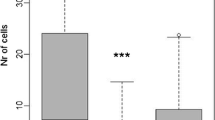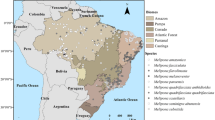Abstract
Fragmentation is one of the many threats that leads to the decline in the population of bees, and stingless bees compose the most abundant pollinator group in the neotropical rain forests. Considering the importance of forested areas to the presence of bees that forage above the ground and nest in trees, this study aimed to discuss the effectiveness of artificial bee shelters as a strategy for the conservation of stingless bees in fragmented habitats. Artificial bee shelters (n = 72) were installed in Atlantic Forest patches and were monitored for 8 months. Four (5.5%) artificial shelters were successfully colonized by Scaptotrigona postica (Latreille, 1807) and 23 (32%) shelters contained signs of initial colonization or traces of dead stingless bees. Difficulties faced by the bees in colonizing the artificial bee shelters included water accumulation, predation, and occupation by other species. The occurrence of Scaptotrigona bees may be related to the group’s need to nest in the hollows of living trees. The artificial shelters supported the swarming of Scaptotrigona bees by providing nesting sites that assisted in their self-maintenance in highly fragmented forest patches with scarce adequate nesting sites. The use of artificial bee shelters can be a strategy for studying stingless bees in their natural environment and for evaluating conservation strategies.


Similar content being viewed by others
References
Aleixo KP, Menezes C, Imperatriz Fonseca VL, da Silva CI (2016) Seasonal availability of floral resources and ambient temperature shape stingless bee foraging behavior (Scaptotrigona aff. depilis). Apidologie 48:117–127. https://doi.org/10.1007/s13592-016-0456-4
Arena MVN, Martines MR, da Silva TN. Destéfani FC, Mascotti JCS, Silva-Zacarin ECM, Toppa RH (2018) Multiple-scale approach for evaluating the occupation of stingless bees in Atlantic forest patches. For Ecol Manage 430:509–516. https://doi.org/10.1016/j.foreco.2018.08.038
Batista MA, Ramalho M, Soares AEE (2003) Nesting sites and abundance of Meliponini (Hymenoptera: Apidae) in heterogeneous habitats of the Atlantic Rain Forest. Bahia Brazil Lundiana 4:19–23
Baum K, Haynes KJ, Dillemuth FP, Cronin JT (2004) The matrix enhances the effectiveness of corridors and stepping stones. Ecology 85:2671–2676. https://doi.org/10.1890/04-0500
Bawa KS (1990) Plant-pollinator interactions in tropical rain forests. Annu Rev Ecol Syst 21:399–422. https://doi.org/10.1146/annurev.ecolsys.21.1.399
Boscolo D, Candia-Gallardo C, Awade M, Metzger JP (2008) Importance of interhabitat gaps and stepping-stones for lesser woodcreepers (Xiphorhynchus fuscus) in the Atlantic Forest, Brazil. Biotropica 40:273–276. https://doi.org/10.1111/j.1744-7429.2008.00409.x
Brosi BJ (2009) The complex responses of social stingless bees (Apidae: Meliponini) to tropical deforestation. For Ecol Manage 258:1830–1837. https://doi.org/10.1016/j.foreco.2009.02.025
Brown JC, Albrecht C (2001) The effect of tropical deforestation on stingless bees of the genus Melipona (Insecta: Hymenoptera: Apidae: Meliponini) in central Rondonia. Brazil J Biogeogr 28:623–634. https://doi.org/10.1046/j.1365-2699.2001.00583.x
Centro de Pesquisas Meteorológicas e Climáticas Aplicadas a Agricultura - CEPAGRI (2017) Clima dos Municípios Paulistas. Centro de Pesquisas Meteorológicas e Climáticas aplicadas a Agricultura. http://www.cpa.unicamp.br/outras-informacoes/clima_muni_511.html. Accessed 05 June 2017
Eltz T, Brühl CA, Imiyabir Z, Linsenmair KE (2003) Nesting and nest trees of stingless bees (Apidae: Meliponini) in lowland dipterocarp forests in Sabah, Malaysia, with implications for forest management. For Ecol Manag 172:301–313. https://doi.org/10.1016/S0378-1127(01)00792-7
Engels W (1990) Social insects: an evolutionary approach to castes and reproduction. Springer, New York, 265 pp
Engels W, Rosenkranz P, Engels E (1995) Thermoregulation in the nest of the Neotropical Stingless bee Scaptotrigona postica and a hypothesis on the evolution of temperature homeostasis in highly Eusocial bees. Stud Neotrop Fauna Environ 39:193–205. https://doi.org/10.1080/01650529509360958
Ferreira PA, Boscolo D, Carvalheiro LG, Biesmeijer JC, Rocha PLB, Viana BF (2015) Responses of bees to habitat loss in fragmented landscapes of Brazilian Atlantic Rainforest. Landsc Ecol 30:2067–2078. https://doi.org/10.1007/s10980-015-0231-3
Gillies CS, Beyer HL, St. Clair CC (2011) Fine-scale movement decisions of tropical forest birds in a fragmented landscape. Ecol Appl 21:944–954. https://doi.org/10.1890/09-2090.1
Goulson D, Nicholls E, Botias C, Rotheray EL (2015) Bee declines driven by combined stress from parasites, pesticides, and lack of flowers. Science 347:1255957. https://doi.org/10.1126/science.1255957
Haddad NM (2000) Corridor length and patch colonization by a butterfly, Junonia coenia. Conserv Biol 14:738–745. https://doi.org/10.1046/j.1523-1739.2000.99041.x
Instituto Nacional de Meteorologia—INMET (2017) Consulta Dados da Estação Automática: Sorocaba (SP). http://www.inmet.gov.br/portal/index.php?r=estacoes/estacoesAutomaticas. Accessed on 27 July 2017
Kerr WE, Nascimento VA, Carvalho GA (1999) Preservation of native Brazilian bees: a question of historical and ecological conscience. Ciência e cultura 51:390–393
Klein AM, Steffan-Dewenter I, Buchori D, Tscharntke T (2002) Effects of land-use intensity in tropical agroforestry systems on coffee flower-visiting and trap-nesting bees and wasps. Conserv Biol 16:1003–1014. https://doi.org/10.1046/j.1523-1739.2002.00499.x
Macieira OJD, Proni EA (2004) Capacidade de resistência a altas e baixas temperaturas em operárias de Scaptotrigona postica (Latreille) (Hymenoptera, Apidae) durante os períodos de verão e inverno. Rev Bras Zool 21:893–896. https://doi.org/10.1590/S0101-81752004000400025
Mandujano S, Escobedo-Morales LA, Palacios-Silva R (2004) Movements of Alouatta palliata among forest fragments in Los Tuxtlas, Mexico. Neotrop Primates 12:126–131. https://doi.org/10.1896/1413-4705.12.3.126
Matlack GR (1993) Sociological edge effects: spatial distribution of human impact in suburban forest fragments. Environ Manage 17:829–835. https://doi.org/10.1007/BF02393903
Matos MCB, Sousa-Souto L, Almeida RS, Teodoro AV (2012) Contrasting patterns of species richness and composition of solitary wasps and bees (Insecta: Hymenoptera) According to Land-use. Biotropica 0:1–7
Michener CD (2007) The bees of the world. JHU Press, Baltimor, p 963
Murcia C (1995) Edge effects in fragmented forests: implications for conservation. Trends Ecol Evol 10:58–62. https://doi.org/10.1016/S0169-5347(00)88977-6
Myers N, Mittermeier RA, Mittermeier CG et al (2000) Biodiversity hotspots for conservation priorities. Nature 403:853–858. https://doi.org/10.1038/35002501
Nogueira-Neto P (1997) Vida e Criação de Abelhas Indígenas Sem Ferrão. Nogueirapis, São Paulo, p 445
Oliveira RC, Menezes C, Soares AEE, Fonseca VLI (2013) Trap-nests for stingless bees (Hymenoptera, Meliponini). Apidologie 44:29–37. https://doi.org/10.1007/s13592-012-0152-y
Pires VR, de Garcia MA, Martines MR, Toppa RH (2016a) Land use and occupation mapping as support to environmental planning. Ambiência 12:899–908. https://doi.org/10.5935/ambiencia.2016.Especial.15
Pires VR, de Garcia MA, Martines MR, Toppa RH (2016b) Landscape structure analysis for the establishment of conservation strategies in Atlantic Forest patches. Ambiência 12:765–774. https://doi.org/10.5935/ambiencia.2016.Especial.01
Potts SG, Biesmeijer JC, Kremen C, Neumann P, Schweiger O, Kunin WE (2010) Global pollinator declines: trends, impacts and drivers. Trends Ecol Evol 25:345–353. https://doi.org/10.1016/j.tree.2010.01.007
Ribeiro MC, Metzger JP, Martensen AC, Ponzoni FJ, Hirota MM (2009) The Brazilian Atlantic Forest: How much is left, and how is the remaining forest distributed? Implications for conservation. Biol Conserv 142:1141–1153. https://doi.org/10.1016/j.biocon.2009.02.021
Roberts HP, King DI, Milam J (2017) Factors affecting bee communities in forest openings and adjacent mature forest. For Ecol Manage 394:111–122. https://doi.org/10.1016/j.foreco.2017.03.027
Roubik DW (1989) Ecology and natural history of tropical bees. Cambridge University Press, New York
Saura S, Bodin Ö, Fortin MJ (2014) Stepping stones are crucial for species’ long-distance dispersal and range expansion through habitat networks. J Appl Ecol 51:171–182. https://doi.org/10.1111/1365-2664.12179
Silva MD, Ramalho M, Monteiro D (2014) Communities of Social Bees (Apidae: Meliponini) in Trap-Nests: the spatial dynamics of reproduction in an area of Atlantic forest. Neotrop Entomol 43:307–313. https://doi.org/10.1007/s13744-014-0219-8
Siqueira ENL, Bartelli BF, Nascimento ART, Nogueira-Ferreira FH (2012) Diversity and nesting substrates of stingless bees (Hymenoptera, Meliponina) in a forest remnant. Psyche (New York) 2012:1–9. https://doi.org/10.1155/2012/370895
Slaa EJ (2006) Population dynamics of a stingless bee community in the seasonal dry lowlands of Costa Rica. Insects Soc 53:70–79. https://doi.org/10.1007/s00040-005-0837-6
Stangler ES, Hanson PE, Steffan-Dewenter I (2016) Vertical diversity patterns and biotic interactions of trap-nesting bees along a fragmentation gradient of small secondary rainforest remnants. Apidologie 47:527–538. https://doi.org/10.1007/s13592-015-0397-3
Storck-Tonon D, Peres CA (2017) Forest patch isolation drives local extinctions of Amazonian orchid bees in a 26 years old archipelago. Biol Conserv 214:270–277. https://doi.org/10.1016/j.biocon.2017.07.018
Van Rossum F, Ludwig T (2012) Stepping-stone populations in linear landscape elements increase pollen dispersal between urban forest fragments. Plant Ecol Evol 145:332–340. https://doi.org/10.5091/plecevo.2012.737
Vollet-Neto A, Koffler S, dos Santos CF, Menezes C, Nunes FMF, Hartfelder K, Imperatriz-Fonseca VL, Alves DA (2018) Recent advances in reproductive biology of stingless bees. Insectes Soc 65:201–212. https://doi.org/10.1007/s00040-018-0607-x
Winfree R (2010) The conservation and restoration of wild bees. Ann NY Acad Sci 1195:169–197. https://doi.org/10.1111/j.1749-6632.2010.05449.x
Zheng Q, Matis JH (1993) Some applications, properties and conjectures for higher order cumulants of a markovian stepping-stone model. Commun Stat Theory Methods 22:3305–3319. https://doi.org/10.1080/03610929308831217
Acknowledgements
We are thankful to SISBIO which authorized the collection of bees; to Dr. Favízia Freitas de Oliveira (Institute of Biology, Federal University of Bahia) for identifying the bees and to Dr. Cláudia Inês da Silva (Institute of Biology, University of São Paulo) for all the assistance provided; to all the land owners who cordially authorized the survey to be taken in their properties; to the farm caretakers who kindly received us; to Roberto from Meliponário Itu, who graciously provided us with a wealth of information; to Maria Virginia Urso Guimaraes and to Denise de Araujo Alves for the valuable notes to the article.
Funding
This research did not receive any specific grant from funding agencies in the public, commercial, or not-for-profit sectors.
Author information
Authors and Affiliations
Corresponding authors
Ethics declarations
Conflict of interest
The authors declare that they have no conflict of interest.
Electronic supplementary material
Below is the link to the electronic supplementary material.
Supplementary material 4 (MP4 42257 KB). Colonized artificial shelter.
Rights and permissions
About this article
Cite this article
Arena, M.V.N., Destéfani, F.C., da Silva, T.N. et al. Challenges to the conservation of stingless bees in Atlantic Forest patches: old approaches, new applications. J Insect Conserv 22, 627–633 (2018). https://doi.org/10.1007/s10841-018-0090-8
Received:
Accepted:
Published:
Issue Date:
DOI: https://doi.org/10.1007/s10841-018-0090-8




